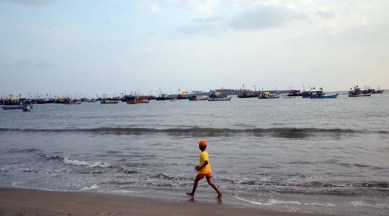Stay updated with the latest - Click here to follow us on Instagram
Mumbai, Dhaka, London, New York among metros in line of sea-level rise threat: report
According to future estimates based on climate models and ocean-atmosphere physics, the WMO reported that the speed of melting of the largest global ice mass in Antarctica is uncertain.

India, China, Bangladesh and the Netherlands face the highest threat of sea-level rise globally, according to a new report by the World Meteorological Organisation (WMO), released on Tuesday.
The report — “Global Sea-level Rise and Implications” — stated that several big cities in all continents are threatened by the rise in sea level. These include Shanghai, Dhaka, Bangkok, Jakarta, Mumbai, Maputo, Lagos, Cairo, London, Copenhagen, New York, Los Angeles, Buenos Aires and Santiago.
monthly limit of free stories.
with an Express account.
“It is a major economic, social and humanitarian challenge. Sea-level rise threatens coastal farmlands and water reserves and resilience of infrastructures as well as human lives and livelihoods,” the report noted. “The impacts of average sea-level rise are boosted by storm surges and tidal variations, as was the situation during the landfall of hurricane Sandy in New York and Cyclone Idai in Mozambique.”
According to future estimates based on climate models and ocean-atmosphere physics, the WMO reported that the speed of melting of the largest global ice mass in Antarctica is uncertain.
While sea-level rise is not globally uniform and varies regionally, continued and accelerating sea-level rise will “encroach on coastal settlements and infrastructure and commit low-lying coastal ecosystems to submergence and loss”, according to the report.
“If trends in urbanisation in exposed areas continue, this will exacerbate the impacts, with more challenges where energy, water and other services are constrained,” it reported. “Climate change will increasingly put pressure on food production and access, especially in vulnerable regions, undermining food security and nutrition and increases in frequency, intensity and severity of droughts, floods and heatwaves, and continued sea level rise will increase risks to food security in vulnerable regions.”
According to WMO, the population potentially exposed to a 100-year coastal flood is projected to increase by about 20% if global mean sea level rises by 0.15 metres relative to 2020 levels. This exposed population doubles at a 0.75-metre rise in mean sea level and triples at 1.4 metres rise without population change.
“Urban systems are critical, interconnected sites for enabling climate resilient development, especially at the coast. Coastal cities and settlements play a key role in moving toward higher climate resilient development given firstly, almost 11% of the global population — 896 million people — lived within the Low Elevation Coastal Zone in 2020, potentially increasing to beyond 1 billion people by 2050, and these people, and associated development and coastal ecosystems, face escalating climate compounded risks, including sea level rise,” it stated.